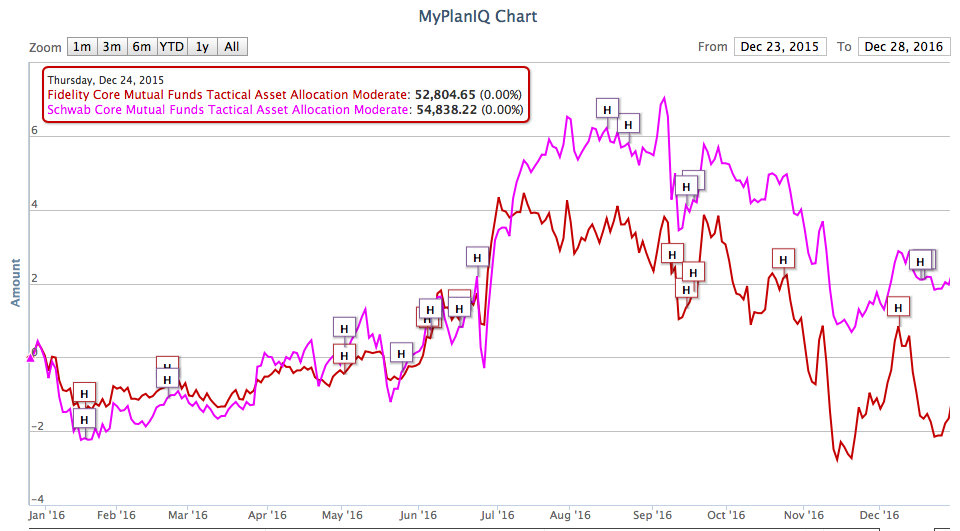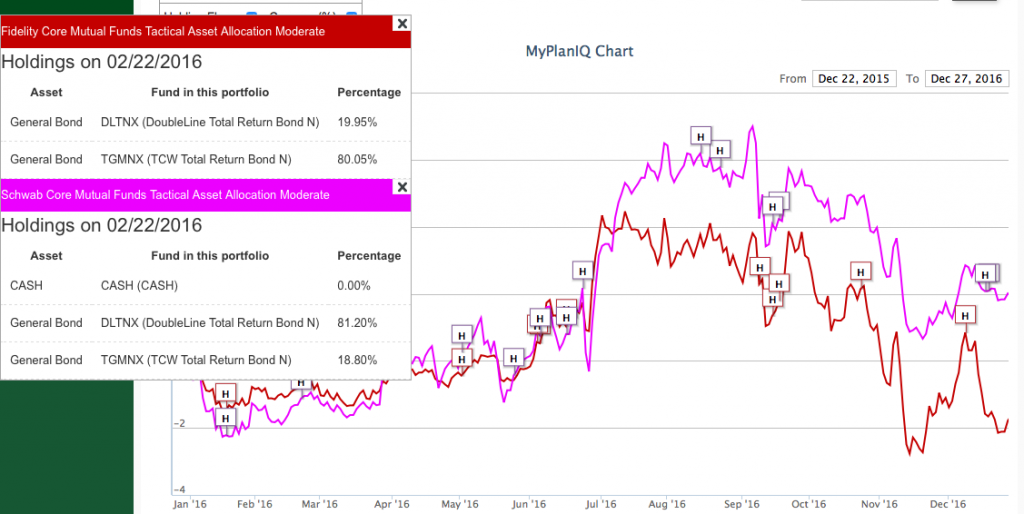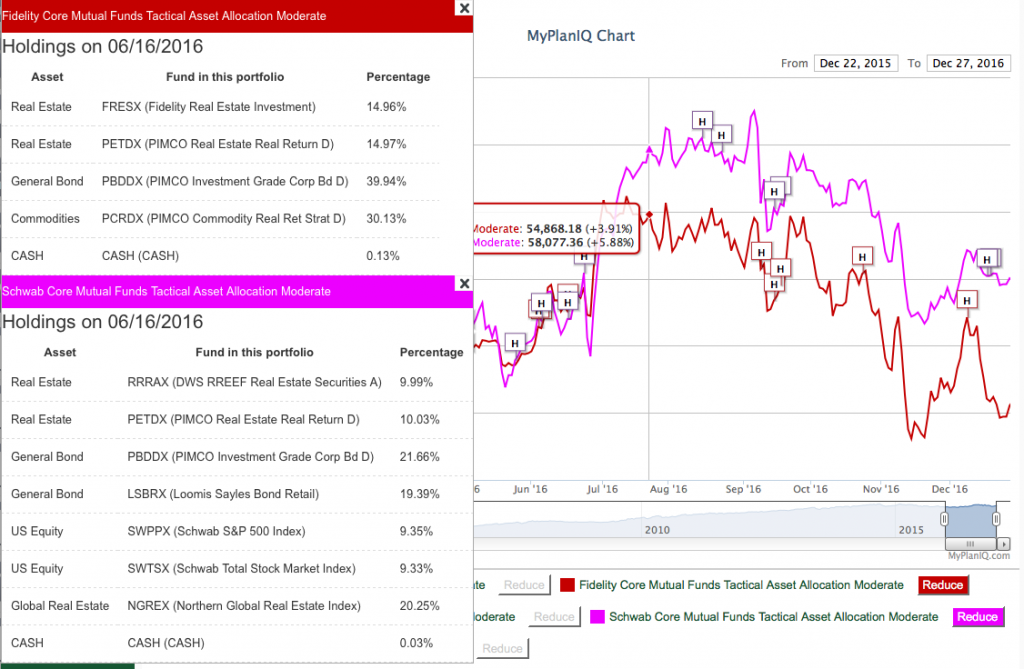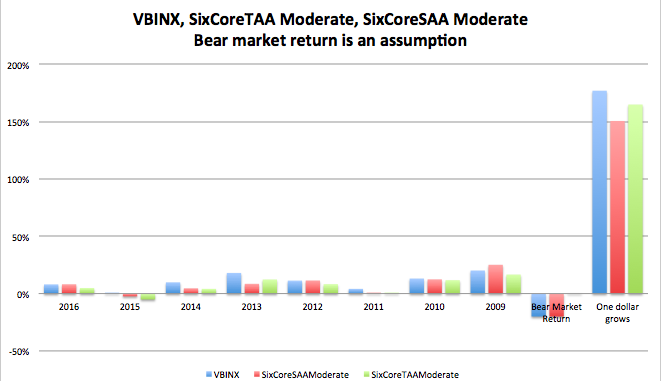Tactical Asset Allocation Review
MyPlanIQ provides model portfolios for brokerage investment accounts and 401k retirement plans. Our free and basic subscription allows users to customize and follow asset allocation model portfolios using either Strategic Asset Allocation (SAA) or Tactical Asset Allocation strategies. In this newsletter, we continue our 2016 review on Tactical Asset Allocation(TAA) portfolios.
TAA portfolios, compared with SAA or just a plain US stocks and US bonds balanced portfolios such as VBINX (Vanguard Balanced Index Inv), continued to lag behind in terms of returns.
Let’s first look at their 2016 performance.
Performance of tactical asset allocation portfolios in 2016
For representative model portfolios listed on Brokerage Investors page, let’s first look at the ETF portfolios:
More detailed year to year comparison >>
Other than Etrade and Fidelity portfolios, all of our TAA ETF portfolios underperformed the 60% US stocks and 40% bonds VBINX. This is not surprising as our TAA works on a set of global assets instead of just US stocks. In fact, our SAA portfolios also underperformed last year (see previous newsletter).
In the table, we also compare these portfolios with several representative tactical allocation mutual funds (they are global allocation funds). In general, most of our TAA portfolios have done better than these funds, other than PASDX (PIMCO All Asset D), which had a stellar year after a string of bad years. Another big disappointment is WASYX (Ivy Asset Strategy Y) that had a loss.
The performance indicates the difficulty for many global tactical allocation portfolios last year. Markets in the past several years have not been good for tactical portfolios. To some extent, this is not surprising as many other assets have exhibited trendless behavior in most time, punctuated with fast gyration because of certain events, only being calmed down by the intervention of central banks and/or governments. Below, we will examine closely a tactical portfolio to understand more.
Tactical mutual fund based portfolios
Let’s first look at the model portfolios for major brokerages, listed on Brokerage Investors page:
Portfolio performance (as of 12/30/2016)
| Ticker/Portfolio Name | 1Yr AR | 3Yr AR | 5Yr AR | 10Yr AR |
|---|---|---|---|---|
| Schwab Core Mutual Funds Tactical Asset Allocation Moderate | 2.2% | 0.7% | 5.9% | 8.1% |
| Fidelity Core Mutual Funds Tactical Asset Allocation Moderate | -1.2% | 0.4% | 6.1% | 7.6% |
| Vanguard Select Mutual Funds Tactical Asset Allocation Moderate | 5.0% | 1.4% | 5.7% | 8.1% |
| Schwab Income Mutual Fund Select List Tactical Asset Allocation Moderate | 4.7% | 0.3% | 4.9% | 6.4% |
| Etrade Core Mutual Funds Tactical Asset Allocation Moderate | 0.5% | 1.4% | 6.3% | 8.5% |
| Merrill Edge Core Mutual Funds Tactical Asset Allocation Moderate | 1.4% | 1.4% | 6.7% | 9.0% |
In 2016, these mutual fund based portfolios did worse than the ETF portfolios in the same brokerage. Several anxious users have asked us to explain the bad performance for these portfolios, in particular, the Fidelity portfolio. In the following, we look at the historical holdings of the Fidelity portfolio, compared with the Schwab portfolio, which performed better.
In the following charts, the light blue line represents the Schwab portfolio.
First, let’s compare the total return charts of the two portfolios in 2016:
From the charts, one can see that the two portfolios performed closely until June and then the big divergence happened in July. Let’s look at their February holdings:
The two portfolios had similar holdings, both are holding two total return bond funds. Then in June their holdings started to differ:
The Schwab portfolio held Real Estate, US Equity, Global Real Estate and General Bond funds. The Fidelity portfolio, on the other hand, held commodities, Real Estate and General Bond funds, no US Equity and no Global Real Estate funds. The reason is that in the Fidelity plan, there is no Global Real Estate funds as its candidate funds. So instead, it had to choose commodities. Meanwhile, in the Schwab portfolio, it had Global Real Estate asset class covered and this changed the relative rankings of the major asset classes.
This divergence is the main culprit that caused the big divergence (and holdings) from July on. We will not go into details on what happened afterwards. But the difference in May to June is the main starting point.
A user asked us what we planned to address this problem. In a short answer, we believe this is just a short term issue. We are confident that in a longer term, the two portfolios will converge more or less. However, it’s also possible to add some global real estate NTF funds in the Fidelity plan. We are still working on this.
The above phenomenon also reveals the short term sensitivity of tactical (aka timing) strategies. One can see that a relative minor difference can alter the behavior in some dramatic way. However, in the long term, we believe as long as the portfolios have many major asset classes in common and have similar funds such as broadly diversified (index) funds, such short term divergence won’t change much the outcome.
We would also like to comment, without going into details, that the main reason why our core mutual funds based portfolios did worse than ETF based portfolios is mostly due to the minimum holding period restriction: in an ETF portfolio, the minimum holding period for an ETF is set to be 30 days which is the shortest time needed anyway since we are rebalancing every 30 days or longer. In a mutual fund based portfolio, many mutual funds are held for more than 90 days. However, we would also remind users that in a 5 year or longer time period, such a restriction again does not affect the performance much. In fact, the tables above show that our mutual fund based portfolios mostly did better than their ETF portfolios in these longer periods.
We would also like to make an observation that the tactical strategies do not necessarily pick the eventual winners in a period as long as one year. For example, after the facts, one can see that emerging market stocks, commodities and US stocks were three winners, each gaining more than 10% in 2016. However, due to the interim behavior, our TAA portfolios didn’t always stick to these assets in the whole time. This tells us that a simple cursory based on the performance in a period does not always necessarily guarantee an often wishful thinking to pick those winners.
Full market cycle performance study
Though the performance of our TAA has been disappointing, compared with the popular US stock index (such as S&P 500) or US centric balance portfolios (such as Vanguard balance index fund VBINX), we want to emphasize that the performance is expected: our goal for tactical portfolios is to achieve a reasonable good returns in a full market cycle that consists of a bear market and a bull market period. This means that we will need to avoid big loss in a bad time while having some reasonable returns when markets are good. Let’s compare the performance of our typical Six Core TAA Moderate, Six Core SAA Moderate and VBINX since 2009:
| VBINX | SixCoreSAAModerate | SixCoreTAAModerate | |
| 2016 | 8% | 8.1% | 4.80% |
| 2015 | 0.40% | -2.40% | -5.10% |
| 2014 | 9.80% | 4.60% | 4.10% |
| 2013 | 18% | 8.5% | 12.30% |
| 2012 | 11.30% | 11.40% | 8.20% |
| 2011 | 4.10% | 0.30% | 0.60% |
| 2010 | 13.10% | 12.40% | 11.70% |
| 2009 | 20.10% | 25.10% | 16.60% |
| Bear Market Return | -20.00% | -20.00% | 0.00% |
| One dollar grows | 1.77 | 1.51 | 1.65 |
| 2008 Actual Return | -22.2% | -24.6% | 1.9% |
In the above, we assume in a bear market, VBINX will drop 20% (compared with its -22.2% in 2008), SAA Moderate will drop 20% (compared with -24.6% in 2008) and TAA Moderate has 0% return (compared with its 1.9% in 2008). What we can see is that TAAModerate will outperform SAAModerate and become much closer to VBINX in terms of their compound total returns, but would do so with much smaller risk.
The above is based on a hypothetical bear market return. But one can see that the TAA will still achieve our original goal if the upcoming bear market does strike. We would also like to emphasize the 20% loss assumption for VBINX or SAA Moderate is really a run of mill assumption as right now, stocks (especially US stocks) are more expensive than in 2007 by our long term valuation metrics (see Market Indicators).
Market Overview
Last week, stocks and bonds all rose in a continuing euphoric mood. As US dollar drops, emerging market and developed market stocks rose sharply. US bonds stabilized. As the price of risk assets like stocks and REITs is increasing in each passing day, the risk of loss is becoming higher. On the other hand, recognizing our inability to forecast markets in near term, the best defense for an investor is to manage his/her overall risk allocation properly and stick to well defined and sound strategies.
For more detailed asset trend scores, please refer to 360° Market Overview.
As now we have a president elect who promised to challenge the status quo and make substantial structural change (such as infrastructure building), we are now in a wait and see period: as the nation is posed to invest, the most important factor to watch is how productive the investments will be. Simply put, productive investments will result in better return on investment (ROI), tangibly or intangibly. They should also increase productivity that in turns will improve our standard of living. Capital misallocation can result in a higher growth but might not improve the real standard of living, which is the ultimate goal of economic activities.
In terms of investments, U.S. stock valuation is at a historically high level. It is thus not a good time to take excessive risk. However, we remain optimistic on U.S. economy in the long term and believe much better investment opportunities will arise in the future.
We again would like to stress for any new investor and new money, the best way to step into this kind of markets is through dollar cost average (DCA), i.e. invest and/or follow a model portfolio in several phases (such as 2 or 3 months) instead of the whole sum at one shot.
Latest Articles
- January 3, 2017: Strategic Asset Allocation Review
- December 5, 2016: Review Of Broad Base Core Mutual Funds For Brokerages
- November 28, 2016: Core Index ETFs Review
- November 21, 2016: International Exposure Of U.S. Large Companies
- November 7, 2016: Rising Rate And Current Bond Trend
- October 31, 2016: Economy Power And Long Term Stock Returns
- October 24, 2016: Current Commodity Trend And Managed Futures
- October 17, 2016: Investment Mistakes And Good Or Bad Investment Strategies
- October 10, 2016: Momentum Investing Review
- October 3, 2016: Survey & Feedback
- September 26, 2016: Fixed Income Investing: Actively Managed Funds vs. Index Funds
- September 19, 2016: Stock Investing: Actively Managed Funds vs. Index Funds
- September 12, 2016: Newsletter Update
- September 5, 2016: Overvalued Markets And Long Term Timing Strategies
- August 29, 2016: Your 401K Finally Draws Attention
- August 22, 2016: Inflation Protected Securities TIPS For Current Overvalued Markets
- August 15, 2016: Risk On: Emerging Market Stocks And Small Cap Stocks
- August 8, 2016: Portfolio Construction Using Stock ETFs And Bond Mutual Funds
- August 1, 2016: Adding Value To Your Own Investments
- July 25, 2016: Tactical Asset Allocation Funds Review
- July 18, 2016: Strategic Asset Allocation & Lazy Portfolio Review
- July 11, 2016: Asset Trend Review
- June 27, 2016: Secular Cycles For Tactical And Strategic Investment Strategies
- June 20, 2016: A World of Debt
- June 13, 2016: Managed Futures For Portfolio Building
- June 6, 2016: Newsletter Summary
- May 30, 2016: Swensen Portfolio And Permanent Portfolios
- May 23, 2016: AAII Article And Some Web Changes
- May 16, 2016: The PIMCO (Dis)Advantages
- May 9, 2016: Boost Your Dull Summer Investments
- May 2, 2016: Low Cost Index Fund Investing
- April 25, 2016: Tax Free Municipal Bond Funds & Portfolios
- April 18, 2016: Asset Class Trend Review
- April 11, 2016: Construction of Sound And Conservative Portfolios
- March 28, 2016: Total Return Bond ETFs Review
- March 21, 2016: Small And Large Company Stock Performance In Different Economic Expansion Cycles
- March 14, 2016: Are Tactical And Timing Strategies Losing Steam?
- March 7, 2016: Defined Maturity Bond Fund Analysis
- February 29, 2016: Smart Strategic Asset Allocation Rebalance When Market Trend Changes
- February 22, 2016: Be Cash Smart
- February 15, 2016: Bond ETF Portfolios
- February 8, 2016: Newsletter Collection Update
- February 1, 2016: Total Return Bond Fund Portfolios In A Volatile Period
- January 25, 2016: Alternative Portfolios Review
- January 18, 2016: Strategic Asset Allocation: A Cautious Outlook
- January 11, 2016: Review Of Trend Following Tactical Asset Allocation
- January 4, 2016: What Worked And Didn’t In 2015
- December 21, 2015: Distressed Assets
- December 14, 2015: High Yield Bonds And Their Correlation With Stocks
- December 7, 2015: Diversification And Global Allocation
- November 30, 2015: Investors and Speculators Combined
- November 23, 2015: Active Stock Fund Performance Consistency
- November 16, 2015: Permanent, Risk Parity And Alternative Portfolios Review
- November 9, 2015: Broad Base Core Mutual Fund Review
- November 2, 2015: Broad Base Index Core ETFs Review
- October 26, 2015: Total Return Bond Fund Review
- October 19, 2015: Advanced Portfolio Review
- October 12, 2015: What About Commodities?
- October 5, 2015: Core Satellite Portfolios In A 401k Account
- September 28, 2015: Risk Managed Strategic Asset Allocation Portfolios Revisited
- September 21, 2015: Quest For The Best Investment Strategy
- September 14, 2015: Core Satellite Portfolios In Market Turmoil
- September 7, 2015: Market Rout Creates An Opportunity to Reposition Your Portfolios
- August 31, 2015: Review of Asset Allocation Funds and Portfolios
- August 24, 2015: Market Rout And Your Portfolios
- August 17, 2015: ETF or Mutual Fund Based Portfolios
- August 10, 2015: Updated Newsletter Collection
- August 3, 2015: Slippery Asset Trends
- July 27, 2015: Performance Dispersion Among Momentum Based Portfolios
- July 20, 2015: Global Balanced Portfolio Benchmarks
- July 13, 2015: Pain in Tactical Portfolios
- July 6, 2015: Fixed Income Total Return Bond Funds In Strategic Asset Allocation Portfolios
- June 29, 2015: Core ETF Commission Free Portfolios
- June 22, 2015: Secular Asset Trends
- June 15, 2015: Giving Up Bonds?
- June 1, 2015: Summer Blues?
- May 26, 2015: Cash, Bonds and Stocks In A Rising Rate Environment
- May 18, 2015: Portfolio Update
- May 11, 2015: Pain in Fixed Income?
- May 4, 2015: The Balanced Stock and Long Term Treasury Bond Portfolios
- April 27, 2015: Long Term Treasury Bond Behavior
- April 20, 2015: 529 College Savings Plan Rebalance Policy Change
- April 13, 2015: Total Return Bond Funds As Smart Cash
- April 6, 2015: The Low Return Environment
- March 30, 2015: Brokerage Specific Core Mutual Fund Portfolios 2
- March 23, 2015: Investment Arithmetic for Long Term Investments
- March 16, 2015: Brokerage Specific Core Mutual Fund Portfolios
- March 9, 2015: Newsletter Collection Update
- March 2, 2015: Total Return Bond ETFs
- February 23, 2015: Why Is Global Tactical Asset Allocation Not Popular?
- February 16, 2015: Where Are Permanent Portfolios Going?
- February 9, 2015: How Have Asset Allocation Funds Done?
- February 2, 2015: Risk Management Everywhere
- January 26, 2015: Composite Portfolios Review
- January 19, 2015: Fixed Income Investing Review
- January 12, 2015: How Does Trend Following Tactical Asset Allocation Strategy Deliver Returns
- January 5, 2015: When Forecast Fails
- December 22, 2014: Long Term Asset Returns: How Long Is Long?
- December 15, 2014: Beaten Down Assets
- December 8, 2014: Implementing Core Asset Portfolios In a Brokerage
- December 1, 2014: Two Key Issues of Investment Strategies
- November 24, 2014: Holiday Readings
- November 17, 2014: Retirement Spending Portfolios Update
- November 10, 2014: Fixed Income Or Cash
- November 3, 2014: Asset Trend Review
- October 27, 2014: Investment Loss, Mistakes And Market Cycles
- October 20, 2014: Strategic Portfolios With Managed Volatility
- October 13, 2014: Embrace Volatility
- October 6, 2014: Tips For 401k Open Enrollment
- September 29, 2014: What Can We Learn From Bill Gross’ Departure From PIMCO?
- September 22, 2014: Why Total Return Bond Funds?
- September 15, 2014: Equity And Total Return Bond Fund Composite Portfolios
- September 8, 2014: Momentum Based Portfolios Review
- September 1, 2014: Risk & Diversification: Mint.com Interview
- August 25, 2014: Remember Risk
- August 18, 2014: Consistency, The Most Important Edge In Investing: Tactical Case
- August 11, 2014: What To Do In Overvalued Stock Markets
- August 4, 2014: Is This The Peak Or Correction?
- July 28, 2014: Stock Musings
- July 21, 2014: Permanent Portfolios & Four Pillar Foundation Based Framework
- July 14, 2014: Composite Portfolios Review
- July 7, 2014: Portfolio Behavior During Market Corrections
- June 30, 2014: Half Year Brokerage ETF and Mutual Fund Portfolios Review
- June 23, 2014: Newsletter Collection Update
- June 16, 2014: There Are Always Lottery Winners
- June 9, 2014: The Arithmetic of Investment Mistakes
- June 2, 2014: Tips On Portfolio Rebalance
- May 26, 2014: In Praise Of Low Cost Core Asset Class Based Portfolios
- May 19, 2014: Consistency, The Most Important Edge In Investing: Strategic Case
- May 12, 2014: How To Handle An Elevated Overvalued Market
- May 5, 2014: Asset Allocation Funds Review
- April 28, 2014: Now The Economy Backs To The ‘Old Normal’, Should Our Investments Too?
- April 21, 2014: Total Return Bond Investing In The Current Market Environment
Enjoy Newsletter
How can we improve this newsletter? Please take our survey
–Thanks to those who have already contributed — we appreciate it.





